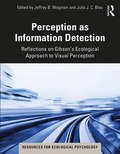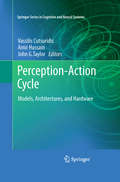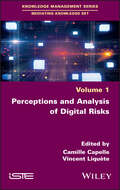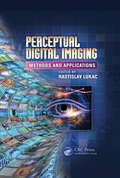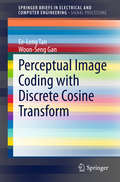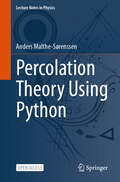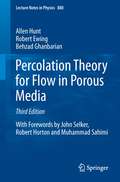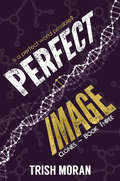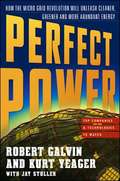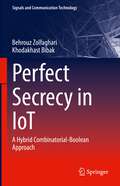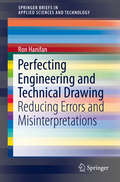- Table View
- List View
Perception as Information Detection: Reflections on Gibson’s Ecological Approach to Visual Perception (Resources for Ecological Psychology Series)
by Jeffrey B. Wagman Julia J. C. BlauThis book provides a chapter-by-chapter update to and reflection on of the landmark volume by J.J. Gibson on the Ecological Approach to Visual Perception (1979). Gibson’s book was presented a pioneering approach in experimental psychology; it was his most complete and mature description of the ecological approach to visual perception. Perception as Information Detection commemorates, develops, and updates each of the sixteen chapters from Gibson’s volume. The book brings together some of the foremost perceptual scientists in the field, from the United States, Europe, and Asia, to reflect on Gibson’s original chapters, expand on the key concepts discussed and relate this to their own cutting-edge research. This connects Gibson’s classic with the current state of the field, as well as providing a new generation of students with a contemporary overview of the ecological approach to visual perception. Perception as Information Detection is an important resource for perceptual scientists as well as both undergraduates and graduates studying sensation and perception, vision, cognitive science, ecological psychology, and philosophy of mind.
Perception as Information Detection: Reflections on Gibson’s Ecological Approach to Visual Perception (Resources for Ecological Psychology Series)
by Jeffrey B. Wagman Julia J. C. BlauThis book provides a chapter-by-chapter update to and reflection on of the landmark volume by J.J. Gibson on the Ecological Approach to Visual Perception (1979).Gibson’s book was presented a pioneering approach in experimental psychology; it was his most complete and mature description of the ecological approach to visual perception. Perception as Information Detection commemorates, develops, and updates each of the sixteen chapters from Gibson’s volume. The book brings together some of the foremost perceptual scientists in the field, from the United States, Europe, and Asia, to reflect on Gibson’s original chapters, expand on the key concepts discussed and relate this to their own cutting-edge research. This connects Gibson’s classic with the current state of the field, as well as providing a new generation of students with a contemporary overview of the ecological approach to visual perception.Perception as Information Detection is an important resource for perceptual scientists as well as both undergraduates and graduates studying sensation and perception, vision, cognitive science, ecological psychology, and philosophy of mind.
Perception, Representations, Image, Sound, Music: 14th International Symposium, CMMR 2019, Marseille, France, October 14–18, 2019, Revised Selected Papers (Lecture Notes in Computer Science #12631)
by Mitsuko Aramaki Richard Kronland-Martinet Sølvi YstadThis book constitutes the refereed proceedings of the 14th International Symposium on Perception, Representations, Image, Sound, Music, CMMR 2019, held in Marseille, France, in October 2019. The 46 full papers presented were selected from 105 submissions. The papers are grouped in 9 sections. The first three sections are related to music information retrieval, computational musicology and composition tools, followed by a section on notations and instruments distributed on mobile devices. The fifth section concerns auditory perception and cognition, while the three following sections are related to sound design and sonic and musical interactions. The last section contains contributions that relate to Jean-Claude Risset's research.
Perception-Action Cycle
by Amir Hussain Vassilis Cutsuridis John G. TaylorThe perception-action cycle is the circular flow of information that takes place between the organism and its environment in the course of a sensory-guided sequence of behaviour towards a goal. Each action causes changes in the environment that are analyzed bottom-up through the perceptual hierarchy and lead to the processing of further action, top-down through the executive hierarchy, toward motor effectors. These actions cause new changes that are analyzed and lead to new action, and so the cycle continues. The Perception-action cycle: Models, architectures and hardware book provides focused and easily accessible reviews of various aspects of the perception-action cycle. It is an unparalleled resource of information that will be an invaluable companion to anyone in constructing and developing models, algorithms and hardware implementations of autonomous machines empowered with cognitive capabilities. The book is divided into three main parts. In the first part, leading computational neuroscientists present brain-inspired models of perception, attention, cognitive control, decision making, conflict resolution and monitoring, knowledge representation and reasoning, learning and memory, planning and action, and consciousness grounded on experimental data. In the second part, architectures, algorithms, and systems with cognitive capabilities and minimal guidance from the brain, are discussed. These architectures, algorithms, and systems are inspired from the areas of cognitive science, computer vision, robotics, information theory, machine learning, computer agents and artificial intelligence. In the third part, the analysis, design and implementation of hardware systems with robust cognitive abilities from the areas of mechatronics, sensing technology, sensor fusion, smart sensor networks, control rules, controllability, stability, model/knowledge representation, and reasoning are discussed.
Perceptions and Analysis of Digital Risks
by Camille Capelle Vincent LiquèteThe concept of digital risk, which has become ubiquitous in the media, sustains a number of myths and beliefs about the digital world. This book explores the opposite view of these ideologies by focusing on digital risks as perceived by actors in their respective contexts.Perceptions and Analysis of Digital Risks identifies the different types of risks that concern actors and actually impact their daily lives, within education or various socio-professional environments. It provides an analysis of the strategies used by the latter to deal with these risks as they conduct their activities; thus making it possible to characterize the digital cultures and, more broadly, the informational cultures at work.This book offers many avenues for action in terms of educating the younger generations, training teachers and leaders, and mediating risks.
Perceptual Digital Imaging: Methods and Applications (Digital Imaging and Computer Vision #6)
by Rastislav LukacVisual perception is a complex process requiring interaction between the receptors in the eye that sense the stimulus and the neural system and the brain that are responsible for communicating and interpreting the sensed visual information. This process involves several physical, neural, and cognitive phenomena whose understanding is essential to design effective and computationally efficient imaging solutions. Building on advances in computer vision, image and video processing, neuroscience, and information engineering, perceptual digital imaging greatly enhances the capabilities of traditional imaging methods. Filling a gap in the literature, Perceptual Digital Imaging: Methods and Applications comprehensively covers the system design, implementation, and application aspects of this emerging specialized area. It gives readers a strong, fundamental understanding of theory and methods, providing a foundation on which solutions for many of the most interesting and challenging imaging problems can be built. The book features contributions by renowned experts who present the state of the art and recent trends in image acquisition, processing, storage, display, and visual quality evaluation. They detail advances in the field and explore human visual system-driven approaches across a broad spectrum of applications, including: Image quality and aesthetics assessment Digital camera imaging White balancing and color enhancement Thumbnail generation Image restoration Super-resolution imaging Digital halftoning and dithering Color feature extraction Semantic multimedia analysis and processing Video shot characterization Image and video encryption Display quality enhancement This is a valuable resource for readers who want to design and implement more effective solutions for cutting-edge digital imaging, computer vision, and multimedia applications. Suitable as a graduate-level textbook or stand-alone reference for researchers and practitioners, it provides a unique overview of an important and rapidly developing research field.
Perceptual Image Coding with Discrete Cosine Transform
by Ee-Leng Tan Woon-Seng GanThis book first introduces classic as well as recent computational models for just-noticeable-difference (JND) applications. Since the discrete cosine transform (DCT) is applied in many image and video standards (JPEG, MPEG-1/2/4, H. 261/3), the book also includes a comprehensive survey of computational models for JND that are based on DCT. The visual factors used in these computational models are reviewed in detail. Further, an extensive comparative analysis of these models using quantitative and qualitative performance criteria is presented, which compares the noise shaping performance of these models with subjective evaluation and the accuracy between the estimated JND thresholds and subjective evaluation. There are many surveys available on computational models for JND; however, these surveys seldom compare the performance of computational models that are based on DCT. The authors' survey of the computational models and their in-depth review of the visual factors used in them will help readers understand perceptual image coding based on DCT. The book also provides a comparative analysis of several perceptual image coders that are based on DCT, which are compatible with the highly popular and widely adopted JPEG standard.
Perchlorate: Environmental Problems and Solutions
by Kathleen Sellers Katherine Weeks William R. Alsop Stephen R. Clough Marilyn Hoyt Barbara Pugh Joseph RobbThe development of analytical methods for identifying widespread perchlorate contamination brought about an explosion of research into the environmental problems and their potential solutions along with a corresponding increase in the availability of information. Unlike reference works that focus on only a few aspects of this contaminant, Perchlora
Percolation Theory Using Python (Lecture Notes in Physics #1029)
by Anders Malthe-SørenssenThis course-based open access textbook delves into percolation theory, examining the physical properties of random media—materials characterized by varying sizes of holes and pores. The focus is on both the mathematical foundations and the computational and statistical methods used in this field. Designed as a practical introduction, the book places particular emphasis on providing a comprehensive set of computational tools necessary for studying percolation theory. Readers will learn how to generate, analyze, and comprehend data and models, with detailed theoretical discussions complemented by accessible computer codes. The book's structure ensures a complete exploration of worked examples, encompassing theory, modeling, implementation, analysis, and the resulting connections between theory and analysis. Beginning with a simplified model system—a model porous medium—whose mathematical theory is well-established, the book subsequently applies the same framework to realistic random systems. Key topics covered include one- and infinite-dimensional percolation, clusters, scaling theory, diffusion in disordered media, and dynamic processes. Aimed at graduate students and researchers, this textbook serves as a foundational resource for understanding essential concepts in modern statistical physics, such as disorder, scaling, and fractal geometry.
Percolation Theory for Flow in Porous Media
by Allen Hunt Robert Ewing Behzad GhanbarianThis monograph presents, for the first time, a unified and comprehensive introduction to some of the basic transport properties of porous media, such as electrical and hydraulic conductivity, air permeability and diffusion. The approach is based on critical path analysis and the scaling of transport properties, which are individually described as functions of saturation. At the same time, the book supplies a tutorial on percolation theory for hydrologists, providing them with the tools for solving actual problems. In turn, a separate chapter serves to introduce physicists to some of the language and complications of groundwater hydrology necessary for successful modeling. The end-of-chapter problems often indicate open questions, which young researchers entering the field can readily start working on. This significantly revised and expanded third edition includes in particular two new chapters: one on advanced fractal-based models, and one devoted to the discussion of various open issues such as the role of diffusion vs. advection, preferential flow vs. critical path, universal vs. non-universal exponents for conduction, and last but not least, the overall influence of the experimental apparatus in data collection and theory validation. "The book is suitable for advanced graduate courses, with selected problems and questions appearing at the end of each chapter. [. . . ] I think the book is an important work that will guide soil scientists, hydrologists, and physicists to gain a better qualitative and quantitative understanding of multitransport properties of soils. " (Marcel G. Schaap, Soil Science Society of America Journal, May-June, 2006)
Percolation, Scaling, and Relaxation in Polymer Dielectrics
by Maheswar PandaThis book provides a foundational understanding of polymer dielectrics based on percolative composites. It covers the microstructure and physical properties, such as dielectric, electrical, magnetic, and rheological properties, of polymer composites, as well as how these properties can be explained using various theoretical models and spectroscopy techniques, such as dielectric spectroscopy, impedance spectroscopy, and conductivity spectroscopy. The book also discusses non-percolative polymer composites and the suitability of polymer dielectrics for electrical energy storage in various devices. It is intended for graduate students and professionals in fields such as condensed matter physics, applied physics, statistical physics, materials science, polymer science and technology, chemistry, and engineering. It will be particularly useful for physicists, materials scientists, polymer scientists, chemists, engineers, and others interested in the physics and applications of percolative composites based on polymer matrix.
Perdicion: The Other Blue Planet
by Alec J. OttIn this space opera adventure, two planets battling for control of another confront a captain on a mission to protect the last known uncolonized planet. When the inhabitants of Perdicion discover there is life on the nearby planet of Parthenos, they rejoice in the possibilities. The most technologically advanced planet in the galaxy, Perdicion now dreams of space travel, exploration, and colonization. But first the forces of Perdicion have to overcome the rebellious Red Colonies, who also wish to make Parthenos their own. What the warring factions don&’t realize is that Parthenos has a protector in Commander Solus, who struggles between his desire to protect the pristine planet and his own need for advancing technology and weapons to use against the tyrants who would destroy the blue planet. The battle for Parthenos pits the past against the future and the old world against the new in pursuit of the soul of the last-known primitive planet.
Perennial Biomass Crops for a Resource-Constrained World
by Michael Jones Susanne Barth Donal Murphy-Bokern Olena Kalinina Gail TaylorThis book presents a flavour of activities focussed on the need for sustainably produced biomass to support European strategic objectives for the developing bioeconomy. The chapters cover five broad topic areas relating to the use of perennial biomass crops in Europe. These are: 'Bioenergy Resources from Perennial Crops in Europe', 'European Regional Examples for the Use of Perennial Crops for Bioenergy', 'Genotypic Selection of Perennial Biomass Crops for Crop Improvement', 'Ecophysiology of Perennial Biomass Crops' and 'Examples of End-Use of Perennial Biomass Crops'. Two major issues relating to the future use of biomass energy are the identification of the most suitable second generation biomass crops and the need to utilise land not under intensive agricultural production, broadly referred to as 'marginal land'. The two main categories of plants that fit these needs are perennial rhizomatous grasses and trees that can be coppiced. The overarching questions that are addressed in the book relate to the suitability of perennial crops for providing feedstocks for a European bioeconomy and the need to exploit environments for biomass crops which do not compete with food crops. Bioenergy is the subject of a wide range of national and European policy measures. New developments covered are, for example, the use of perennial grasses to produce protein for animal feed and concepts to use perennial biomass crops to mitigate carbon emissions through soil carbon sequestration. Several chapters also show how prudent selection of suitable genotypes and breeding are essential to develop high yielding and sustainable second generation biomass crops which are adapted to a wide range of unfavourable conditions like chilling and freezing, drought, flooding and salinity. The final chapters also emphasise the need to be kept an eye out for potential new end-uses of perennial biomass crops that will contribute further to the developing bioeconomy.
Perfect Chemistry (A Perfect Chemistry Triology #1)
by Simone ElkelesFrom the New York Times bestselling author Simone Elkeles comes an epic love story like no other . . . First in the gripping PERFECT CHEMISTRY series, this is the next addictive read for fans of Anna Todd's AFTER series, and Caroline Kepnes's YOU.When Brittany Ellis walks into chemistry class on the first day of senior year, she has no clue that her carefully created 'perfect' life is about to unravel before her eyes. Forced to be lab partners with Alex Fuentes, a gang member from the other side of town, Brittany finds herself having to protect everything she's worked so hard for – her flawless reputation, her relationship with her boyfriend and, most importantly, the secret that her home life is anything but perfect.Alex is a bad boy and he knows it. So when he makes a bet with his friends to lure Brittany into his life, he thinks nothing of it. But the closer Alex and Brittany get to each other the more they realise that sometimes appearances can be deceptive and that you have to look beneath the surface to discover the truth.
Perfect Image: The Clone Series (The Clone Series #3)
by Trish MoranThe final installment of Trish Moran's acclaimed young adult series exploring humanity, technology, and the problems of growing up in a dystopian future. Perfect for fans of The Giver and the Divergent trilogy.The Compound Labs, the original group of clones freed from the notorious medical centre, are continuing to live successfully alongside the normal humans in society.They are uneasy to realize that the militant group of clones, the Radicals, are gaining more and more followers from the Labs and their Hybrid children.The Radicals, sponsored by an anonymous billionaire, have a vision of a future society where every member is given a designated role according to their abilities. They have plans to rule this new way of life with a specially created perfect clone and his equally talented team, showing little regard for those they consider inferior mentally and physically.Have they created a team of unfeeling, super-intelligent people who will stop at nothing to achieve their aims?Are the Compound Labs strong enough to defeat them in their crusade? Can a young Hybrid girl use the power of love and compassion to challenge the course they have set themselves?
Perfect Image: The Clone Series (The\clone Ser. #3)
by Trish MoranThe final installment of Trish Moran's acclaimed young adult series exploring humanity, technology, and the problems of growing up in a dystopian future. Perfect for fans of The Giver and the Divergent trilogy.The Compound Labs, the original group of clones freed from the notorious medical centre, are continuing to live successfully alongside the normal humans in society.They are uneasy to realize that the militant group of clones, the Radicals, are gaining more and more followers from the Labs and their Hybrid children.The Radicals, sponsored by an anonymous billionaire, have a vision of a future society where every member is given a designated role according to their abilities. They have plans to rule this new way of life with a specially created perfect clone and his equally talented team, showing little regard for those they consider inferior mentally and physically.Have they created a team of unfeeling, super-intelligent people who will stop at nothing to achieve their aims?Are the Compound Labs strong enough to defeat them in their crusade? Can a young Hybrid girl use the power of love and compassion to challenge the course they have set themselves?
Perfect Pairs, 3-5: Using Fiction & Nonfiction Picture Books to Teach Life Science, Grades 3-5
by Melissa Stewart Nancy ChesleyHands-on lessons can be fun and compelling, but when it comes to life science, they aren't always possible, practical, effective, or safe. Children can't follow wolves as they hunt elk, visit a prehistoric swamp, or shrink down to the size of a molecule and observe photosynthesis firsthand. But they can explore a whole world of animals, plants, and ecosystems through the pages of beautifully illustrated, science-themed picture books. Perfect Pairs , which marries fiction and nonfiction picture books focused on life science, helps educators think about and teach life science in a whole new way. Each of the twenty lessons in this book is built around a pair of books that introduces a critical life science concept and guides students through an inquiry-based investigative process to explore that idea-;from life cycles and animal-environment interactions to the inheritance of traits and the critical role of energy in our world. Each lesson starts with a Wonder Statement and comprises three stages. Engaging Students features a hands-on activity that captures student interest, uncovers current thinking, and generates vocabulary. The heart of the investigative process, Exploring with Students, spotlights the paired books as the teacher reads aloud and helps students find and organize information into data tables. Encouraging Students to Draw Conclusions shows students how to review and analyze the information they have collected. Bringing high-quality science-themed picture books into the classroom engages a broad range of students, addresses the Performance Expectations outlined in the Next Generation Science Standards, and supports the goals of the Common Core State Standards for English Language Arts. Even if you are science shy, Perfect Pairs can help you become a more confident teacher whose classroom buzzes with curious students eager to explore their natural world.
Perfect Pairs, K-2: Using Fiction & Nonfiction Picture Books to Teach Life Science, K-2
by Melissa Stewart Nancy ChesleyHands-on lessons can be fun and compelling, but when it comes to life science, they aren't always possible, practical, effective, or safe. Children can't follow a lion as it stalks a gazelle, visit the exotic kapok tree in a rain forest, or swim alongside the underwater life in a pond. But they can explore a whole world of animals, plants, and ecosystems through the pages of beautifully illustrated, science-themed picture books. Perfect Pairs , which marries fiction and nonfiction picture books focused on life science, helps educators think about and teach life science in a whole new way. Each of the twenty-two lessons in this book is built around a pair of books that introduces a critical life science concept and guides students through an inquiry-based investigative process to explore that idea-;from animal/environment interactions to the role of structure in plant and animal survival, from inheritance of traits to variation of species. Each lesson starts with a Wonder Statement- and comprises three stages. Engaging Students- features a hands-on activity that captures student interest, uncovers current thinking, and generates vocabulary. The heart of the investigative process, Exploring with Students,- spotlights the paired books as the teacher reads aloud and helps students find and organize information into data tables. Encouraging Students to Draw Conclusions- shows students how to review and analyze the information they have collected. Bringing high-quality science-themed picture books into the classroom engages a broad range of students, addresses the Performance Expectations outlined in the Next Generation Science Standards, and supports the goals of the Common Core State Standards for English Language Arts. Even if you are science shy,Perfect Pairs can help you become a more confident teacher whose classroom buzzes with curious students eager to explore their natural world.
Perfect People
by Peter JamesIf it was the only way of having a child... would you do it? An unputdownable thriller from the global Number One bestseller author of the Roy Grace series.After the tragic loss of their young son to a rare genetic disorder, John and Naomi discover they both carry a rogue gene. Having another child by conventional means is too much risk to bear.When they find geneticist Dr Leo Dettore it seems like the answer to their prayers. Every aspect of the child can be chosen and manufactured, from height and eye colour to intelligence and sporting prowess. But realising the danger too late, Naomi is already pregnant when they understand the nightmare world they are entering…A world of perfect people.Utterly gripping and frighteningly plausible, Perfect People is a shocking thriller you won’t be able to put down about what happens when humans play God.Praise for Perfect People'Peter James's clever page-turner Perfect People focuses not on the past but risks for the future.' The Times'As ever, James writes beautifully, maintaining the pace with short, punchy chapters. But it's his firm grasp of the moral issues surrounding designer babies that makes Perfect People so satisfying – and so unsettling.' Guardian'James has produced a suitably breathless fan-pleaser about accelerating evolution.' Daily Telegraph'The ending is so horrifyingly scary that I was unable to sleep properly for several nights.' Mail on Sunday
Perfect Power: How the Microgrid Revolution Will Unleash Cleaner, Greener, and More Abundant Energy
by Robert Galvin Kurt YeagerWhat's the solution to the world's growing energy problem? ... PERFECT POWER ... Electric usage is rising. Fuel costs are rocketing. Blackouts are happening more frequently. Why? Because our electrical power system--built on a vast network of resources including nuclear energy, natural gas, water, and coal--has become woefully outdated, increasingly expensive, and dangerously fragile. We need to change the current system, and we need to do it now. ..Written by business visionary and former Motorola chairman Robert Galvin,Perfect Powershows us how to create a perfect system that can deliver power where needed, at an astonishing reliability standard of 99.9999999 percent. By super-charging the Six Sigma concepts that Galvin developed as the founder and CEO at Motorola, we can ... Meet the energy reliability and quality needs of the Digital Age. Generate new goods and services that create jobs, empower consumers, and lower energy cost. Eliminate wasteful spending on our electrical infrastructure that can be used for peak power needs. Facilitate local, regional, and, ultimately, national energy independence. Fundamentally reduce the impact of energy on the environment. Invest in the microgrid revolution. ... Energy providers and policy makers will reinvent today's centralized power systems and integrate them with new, efficient microgrids. Investors and entrepreneurs will spot tomorrow's hottest technologies. Consumers will demand change from the powers that be. And environmentalists will take advantage of cleaner, greener energy sources available. ... We have the power to fulfill our energy needs, fix our old systems, forge ahead with new ideas, and fuel our dreams. It's Perfect Power.
Perfect Rigor: A Genius and the Mathematical Breakthrough of the Century
by Masha GessenA gripping and tragic tale that sheds rare light on the unique burden of genius In 2006, an eccentric Russian mathematician named Grigori Perelman solved the Poincare Conjecture, an extremely complex topological problem that had eluded the best minds for over a century. A prize of one million dollars was offered to anyone who could unravel it, but Perelman declined the winnings, and in doing so inspired journalist Masha Gessen to tell his story. Drawing on interviews with Perelman's teachers, classmates, coaches, teammates, and colleagues in Russia and the United States--and informed by her own background as a math whiz raised in Russia--Gessen uncovered a mind of unrivaled computational power, one that enabled Perelman to pursue mathematical concepts to their logical (sometimes distant) end. But she also discovered that this very strength turned out to be Perelman's undoing and the reason for his withdrawal, first from the world of mathematics and then, increasingly, from the world in general.
Perfect Secrecy in IoT: A Hybrid Combinatorial-Boolean Approach (Signals and Communication Technology)
by Khodakhast Bibak Behrouz ZolfaghariPerfectly-secure cryptography is a branch of information-theoretic cryptography. A perfectly-secure cryptosystem guarantees that the malicious third party cannot guess anything regarding the plain text or the key, even in the case of full access to the cipher text. Despite this advantage, there are only a few real-world implementations of perfect secrecy due to some well-known limitations. Any simple, straightforward modeling can pave the way for further advancements in the implementation, especially in environments with time and resource constraints such as IoT. This book takes one step towards this goal via presenting a hybrid combinatorial-Boolean model for perfectly-secure cryptography in IoT. In this book, we first present an introduction to information-theoretic cryptography as well as perfect secrecy and its real-world implementations. Then we take a systematic approach to highlight information-theoretic cryptography as a convergence point for existing trends in research on cryptography in IoT. Then we investigate combinatorial and Boolean cryptography and show how they are seen almost everywhere in the ecosystem and the life cycle of information-theoretic IoT cryptography. We finally model perfect secrecy in IoT using Boolean functions, and map the Boolean functions to simple, well-studied combinatorial designs like Latin squares. This book is organized in two parts. The first part studie s information-theoretic cryptography and the promise it holds for cryptography in IoT. The second part separately discusses combinatorial and Boolean cryptography, and then presents the hybrid combinatorial-Boolean model for perfect secrecy in IoT.
Perfecting Engineering and Technical Drawing
by Ron HanifanThis concise reference helps readers avoid the most commonplace errors in generating or interpreting engineering drawings. Applicable across multiple disciplines, Hanifan's lucid treatment of such essential skills as understanding and conveying data in a drawing, exacting precision in dimension and tolerance notations, and selecting the most-appropriate drawing type for a particular engineering situation, "Perfecting Engineering and Technical Drawing" is an valuable resource for practicing engineers, engineering technologists, and students. Provides straightforward explanation of the requirements for all common engineering drawing types Maximizes reader understanding of engineering drawing requirements, differentiating the types of drawings and their particular characteristics Elucidates electrical reference designation requirements, geometric dimensioning, and tolerancing errors Explains the entire engineering documentation process from concept to delivery
Perfectly Matched Layer (Synthesis Lectures on Computational Electromagnetics)
by Jean-Pierre BérengerThis book presents the perfectly matched layer (PML) absorbing boundary condition (ABC) used to simulate the surrounding free space when solving the Maxwell equations with such finite methods as the finite difference time domain (FDTD) method or the finite element method. The frequency domain and the time domain equations are derived for the different forms of PML media, namely the split PML, the CPML, the NPML, and the uniaxial PML, in the cases of PMLs matched to isotropic, anisotropic, and dispersive media. The implementation of the PML ABC in the FDTD method is described with details. Propagation and reflection of waves in the discretized FDTD space are derived and discussed, with a special emphasize on the problem of evanescent waves. The optimization of the PML ABC is described for two typical applications of the FDTD method, firstly wave-structure interaction problems, secondly waveguide problems. A review of the literature on the application of the PML ABC to other numerical techniques of electromagnetics and to other partial differential equations of physics is provided. Finally, the design of PMLs suited to actual applications is revisited in the context of computers of the 2020’s that are, by far, more powerful than the computers of the 1990’s when the PML ABC was introduced. A simple and general-purpose method is described to design the PML in this current context.
Perfectly Reasonable Deviations From the Beaten Track: The Letters of Richard P. Feynman
by Richard P. FeynmanA Nobel Prize-winning physicist, a loving husband and father, an enthusiastic teacher, a surprisingly accomplished bongo player, and a genius of the highest caliber---Richard P. Feynman was all these and more. Perfectly Reasonable Deviations From the Beaten Track--collecting over forty years' worth of Feynman's letters--offers an unprecedented look at the writer and thinker whose scientific mind and lust for life made him a legend in his own time. Containing missives to and from such scientific luminaries as Victor Weisskopf, Stephen Wolfram, James Watson, and Edward Teller, as well as a remarkable selection of letters to and from fans, students, family, and people from around the world eager for Feynman's advice and counsel, Perfectly Reasonable Deviations From the Beaten Track not only illuminates the personal relationships that underwrote the key developments in modern science, but also forms the most intimate look at Feynman yet available. Feynman was a man many felt close to but few really knew, and this collection reveals the full wisdom and private passion of a personality that captivated everyone it touched. Perfectly Reasonable Deviations From the Beaten Track is an eloquent testimony to the virtue of approaching the world with an inquiring eye; it demonstrates the full extent of the Feynman legacy like never before. Edited and with additional commentary by his daughter Michelle, it's a must-read for Feynman fans everywhere, and for anyone seeking to better understand one of the towering figures--and defining personalities--of the twentieth century.
